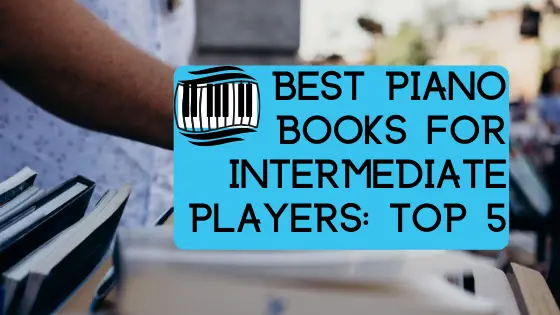Are you an intermediate level piano player wondering what to push onto next?
The intermediate stage of piano playing is one of the most important levels of piano playing in my experience as a musician and private lesson teacher.
Intermediate level is the point just before you press on to being able to play most piano music. For you, it’s all about finishing the fundamental techniques for piano playing. To this end, a good curriculum is essential.
This is why I’ve gone through many books over the years to make this list of the best piano books for intermediate players.
The best piano books for intermediate players need to be engaging and filled with authentic songs while reinforcing and pressing on with fundamentals and techniques. Our picks include:
- John Thompson’s Adult Piano Course – Book 2: Later Elementary to Early Intermediate Level
- Classics to Moderns in the Intermediate Grade
- The Giant Book of Intermediate Classical Piano Music
- Piano Masterworks: Intermediate Level
- 100 Left Hand Patterns Every Piano Player Should Know
- BONUS: Flowkey
Look ahead for specific reviews and more information.
Table of Contents
Review Of The Best Piano Books For Intermediate Players
This section digs into each of these books in a little more detail. Use this information to help you decide which one you want to get.
Note: Prices change all the time, so I’ll mention general price ranges for each product. You’ll have to click the button to check most current pricing.
John Thompson’s Adult Piano Course – Book 2: Later Elementary to Early Intermediate Level
I’ll put this one out here because I’m willing to bet many of you reading this post are adults. Johnson’s book series is geared towards the adult learner, and this second book in his series is made for the intermediate player.
At an affordable price, this book will cover the fundamentals and technical aspects of piano playing you need to get comfortable with in order to move in your abilities.
There are real songs embedded throughout, so it’s pretty easy to stay motivated.
The audio which goes along with this is also artistic and pleasant to listen to. This provides a good model as to what you want your own playing to sound like.
As an adult-focused book, the teaching style of the book provides more details and allows the adult to be more self-directed in their learning.
Pros For This Book:
- Affordable
- Geared towards adults
- Good mix of technique and song
Cons For This Book:
- Not as useful for younger learners
Classics to Moderns in the Intermediate Grade
This book is one I love to pull out and play from personally.
It’s a medium-priced collection of songs at the intermediate level. This book will need to be combined with either a teacher or learning program to help move along your skills and develop your technique.
However, the songs cover a wide range of tunes from the traditional classical to more modern selections.
I like this book because it doesn’t just rehash all the same Classical tunes you hear over and over on piano.
It’s got some unique ones too.
All songs are achievable at an intermediate level (though some will require more practice than others).
Working your way through this book is a great way to get yourself ready for advanced work while still learning songs to actually play for people.
Pros For This Book:
- Wide variety of songs to learn
- Covers classical and modern
- All songs at intermediate level
Cons For This Book:
- No specific or sequenced instruction or exercises
The Giant Book of Intermediate Classical Piano Music
Along the same lines as above, this Giant Book of Classical Piano Music is at a higher price but contains a massive amount of songs.
These songs are all in the classical genre (though not just the classical period of music).
These songs are all achievable for intermediate level players, but there are a few which are quite simple or quite hard for this level.
The songbook is extensive and would take a while to play all the way through, but the variety of songs at this level actually has a technical benefit as well.
Many composers during the time, especially in the Baroque period, wrote songs specifically to be used as technical exercises while still sounding good. Bach in particular was well-known for this.
Many of these songs will work as fundamentals.
However, there isn’t specific instruction included.
Pros For This Book:
- Massive song list
- Good for pushing intermediate players to the next level
- Many of the songs contain technique building skills
Cons For This Book:
- Higher price
- No specific instruction
Check out where to donate a piano if you’re getting a new one.

Piano Masterworks: Intermediate Level
This book is essentially a lighter (and more affordable) version of the book above.
This collection of classical tunes are ones almost everyone knows, even those with limited classical music knowledge.
These songs are all perfect for intermediate players, and they don’t cross the line into too difficult for the most part.
As with songs of this era, many of them are great exercises in developing technical skills. But as a bonus, these “exercises” are actual songs to play.
The book doesn’t contain any specific sequential instruction, but when combined with an instructional book or online program, it’s a masterful combination.
The lower price may help you with getting both this book and the instruction method of your choice.
Pros For This Book:
- Engaging classical songs
- Right at the intermediate level
- Affordable price for the number of songs you receive
Cons For This Book:
- No specific instruction
- No modern songs
100 Left Hand Patterns Every Piano Player Should Know
This book may seem an odd choice as it isn’t specifically made for intermediate players, but this medium-priced book is one I recommend to all piano students regardless of their level.
However, I consider this book a must for intermediate pianists.
The biggest struggle for 99% of piano learners is left-hand coordination.
This book knows this and takes aim square at this problem.
It’s divided into two sections.
The first is a practical and thorough explanation of several important ways to use your left hand to “fill out” a song.
This contains practical exercises and examples to work on the most difficult aspects of piano playing-the left hand.
These exercises and techniques are useful for any piano player at any level.
The second half of the book is a Fake Book. A Fake Book contains the melody of a song and chords.
The chords aren’t spelled out to allow you the freedom to play them how you wish using the techniques learned in the first half of the book.
Basically, you gain a vastly useful skill and are offered a practical application of it all in one place.
The songs used are also largely popular songs you’ve heard before. These are all at different levels, but intermediate players should be able to pick most of these up with a little practice.
Pros For This Book:
- Isolates the left-hand skills
- Fun and engaging songs
- Direct instruction and exercises on important intermediate level skills
Cons For This Book:
- Doesn’t focus on all piano techniques
BONUS: Flowkey
Flowkey is an online piano learning program and app developed by Yamaha.
This program is a perfect tool for intermediate players (and any players really).
Essentially, the program serves two main purposes:
- Video and interactive courses and lessons for each and every level
- A massive 1,500+ song list all with learning tools and videos
Use this alone or in conjunction with any of the books above, and you’ll advance quickly.
Check out the 7 reasons you’ll love the Flowkey piano learning for more details.
Commonly Asked Questions
Can I learn piano without a piano? – Yes! It’s tough, but possible.
Get a keyboard if at all possible. But there are mats and other practice options out there to check out.
Learn about the 5 ways to play without a piano.
How many hours per day should I practice piano? – Well, it depends on how quickly you want to improve.
In general, I tell my students to practice at least 15 minutes per day every day. Going up to an hour should be enough for most people.
More is fine, as long as you don’t get frustrated or bored.
Practice should be done with focus and excitement, not resignation.
Why do pianists lift their hands? – You’ll see this a lot with professional piano players, especially classical ones.
While some consider the lifting to be largely for show, it actually helps the musician connect the feeling of the phrase in their mind and heart.
This impacts how the musician plays the music.
Final Thoughts
I hope you find my list of the best piano books for intermediate players helpful.
If sticking with books only, I recommend John Thompson’s book. It’s quite affordable and has a good mix of instruction with real songs.
You’ll still want more songs to play too, so it would make sense to supplement with one of others. But the Left-hand Pattern book has instruction and songs to learn.
Of course, getting Flowkey (check it out for free) would only help you learn faster and stay motivated.
Pick one and play! Keep on practicing, and you’ll get better and have fun!

